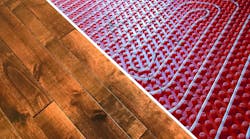Latest from Eatherton
Sponsored
As the chairperson for the Radiant Professionals Alliance’ Technical Committee, I am charged with being involved in any technical developments of codes or standards affecting our members. Within the last year, I was approached by members of the National Wood Flooring Association (NWFA) in regards to developing a standard which they were in the process of developing to limit the operating temperatures of radiant floors covered by wood flooring materials. We (the RPA and NWFA) had been discussing this for many years, and in fact the NWFA commonly refers to standards developed by the RPA in its installation standards, using many of the drawings developed by the RPA, showing all of the different methods available to complete the installation of radiantly heated wood floors.
Brett Miller is the Vice President of the Education and Certification committee of the NWFA. I first met Brett when his organization hired me to come to their annual education meeting/conference in Charlotte N.C. to speak to their members about the many different methods of radiant floor heating, and which systems worked best with wood floors covering them. Brett told me then that they were in the process of putting together a General Radiant Heating Installation guideline for their installers. He said that there was a common thread to many of the wood floor failures that were being inspected and reported upon by his team of certified floor inspectors, and that the common thread was the use of radiant floor heating systems. That raised my eyebrows, because I have over 250,000 square feet of hardwood flooring installations that mostly used hardwood floors, and could only think of one wood floor failure associated with the use of radiant floor heating, and that was job that the general contractor yanked the insulation package because he didn’t think it was necessary due to the misconception that radiant “heat rises.”
It is the responsibility of the wood flooring contractor to bring that humidity control requirement to the table for the owner to acknowledge, but it will most probably become the responsibility of the HVAC contractor to ensure its proper installation, operation and maintenance.
I know many of you have had this same experience (missing insulation), and let me just say for the record that insulation below the radiant floor is not an option, it is required by the IECC energy code. It is your job to make certain that the G.C. is made aware that it is not an option, and that they need to include it or it will affect the ability of your floor heating system to perform, and then it becomes your problem. Including repair and or replacement of over baked wood flooring goods.
The many different methods of wood flooring failure have been well documented, and another commonality to these failures is the lack of a humidity control system. I emphasize control, because having too high of a humidity in the living space can be just as detrimental to the finished wood products and the occupants as low humidity, hence it not only requires the addition of humidity, but in some coastal areas, may require the removal of humidity in order to keep it in the ideal condition of 30 to 50% relative humidity. This is considered the “Comfort Zone” for wood products and is the standard adopted by the NWFA. It is the responsibility of the wood flooring contractor to bring that humidity control requirement to the table for the owner to acknowledge, but it will most probably become the responsibility of the HVAC contractor to ensure its proper installation, operation and maintenance. In my experience, very few of the installations that I have seen had a humidity control system as a part of the installation, and I suspect that this missing element has more to do with the failure of wood flooring than does the introduction of heat, but my expertise is not in the various species of wood floors, so we must defer to this organization and their expertise to limit damaged floors. It is however, very important that the radiant flooring contractor and the hardwood flooring contractor work together with the homeowner to ensure that both of these systems are compatible for the application to keep possible failures to a minimum. For example, certain species have a higher tolerance to being heated than do others.
The NWFA is preparing a chart to show good, better and best wood choices for use in radiant floor heating applications. We always used to think that the cut of the wood (quarter sawn versus plain sawn) was the only thing that really affected wood floor stability, but it has more to do with species and cut. For example, more stable woods species are American Chestnut, Black Cherry, Black Walnut, and others. Less stable species such as Hickory, Birch and Maple are less suitable for use over radiant heat. This standard is not only applicable to solid wood flooring systems, but also the “engineered” wood floor products. Unfortunately, the consumer is much more likely to choose the less stable products for their particular installation. Although it may not be the job of the radiant floor heating installer to help their consumer make this decision, I think it would be wise for them to know and understand this limitation, and bring it up in the course of discovery, so that the consumer is made aware of these limitations.
Temperature limitations. For many years, our members have limited the operating temperature of any floor, regardless of finish, to 85 degrees F. This is standard that was developed by ASHRAE many years ago, and it is based on the fact that most humans can’t tolerate being in contact with a heated surface greater than 85 degrees F. The NWFA standard has established the maximum recommended floor temperature when used with certain wood flooring products as 80 degree F. In most cases, this new limitation will not have any significant effect on the radiant floors’ operation where the heating load is less than 20 Btu’s per square foot per hour. However, in areas of high heat loss, like rooms with floor to ceiling glass walls, the load could easily exceed this 20 Btu per square foot standard adopted by the NWFA for its members products.
Tune in next month as we continue to look at changes in hardwood flooring that will affect our systems.
Mark Eatherton material, in print and online, is protected by Copyright 2017. Any reuse of this material (print or electronic) must first have the express written permission of Mark Eatherton and CONTRACTOR magazine. Please contact via email at [email protected].
Mark Eatherton
Mark Eatherton material on this website is protected by Copyright 2017. Any reuse of this material (print or electronic) must first have the expressed written permission of Mark Eatherton and CONTRACTOR Magazine.


